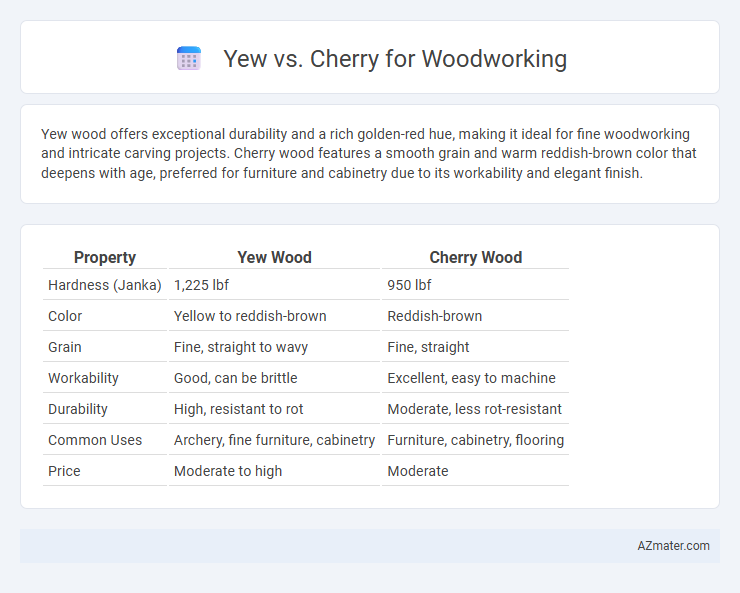Yew wood offers exceptional durability and a rich golden-red hue, making it ideal for fine woodworking and intricate carving projects. Cherry wood features a smooth grain and warm reddish-brown color that deepens with age, preferred for furniture and cabinetry due to its workability and elegant finish.
Table of Comparison
| Property | Yew Wood | Cherry Wood |
|---|---|---|
| Hardness (Janka) | 1,225 lbf | 950 lbf |
| Color | Yellow to reddish-brown | Reddish-brown |
| Grain | Fine, straight to wavy | Fine, straight |
| Workability | Good, can be brittle | Excellent, easy to machine |
| Durability | High, resistant to rot | Moderate, less rot-resistant |
| Common Uses | Archery, fine furniture, cabinetry | Furniture, cabinetry, flooring |
| Price | Moderate to high | Moderate |
Introduction to Yew and Cherry Wood
Yew wood is prized in woodworking for its rich, warm reddish-brown color, fine grain, and natural durability, often used in crafting bows, furniture, and decorative items. Cherry wood offers a smooth texture with a lighter, reddish-pink hue that deepens to a rich mahogany over time, favored for cabinetry, veneers, and intricate woodturning projects. Both woods provide unique aesthetic qualities and workability, but Yew's dense, resinous properties contrast with Cherry's moderate hardness and consistent grain patterns.
Botanical and Physical Characteristics
Yew (Taxus baccata) features a fine, straight grain with a reddish-brown heartwood and pale sapwood, offering high density and elasticity suited for detailed woodworking. Cherry (Prunus serotina) presents a smooth, satiny texture with a rich reddish-brown hue that darkens over time, characterized by moderate hardness and excellent workability. Botanically, Yew is a conifer with needle-like leaves and produces fleshy red arils, while Cherry is a deciduous hardwood with broad leaves and small, dark drupes, influencing their wood grain and finishing qualities.
Workability: Ease of Cutting, Shaping, and Finishing
Yew wood is highly regarded for its fine, even grain that allows for smooth cutting, shaping, and detailed carving with minimal effort, making it ideal for intricate woodworking projects. Cherry wood, known for its consistent texture and moderate hardness, offers excellent workability, sanding smoothly to a rich finish that enhances its natural warm tones. Both woods respond well to hand and power tools, but yew's elasticity and durability provide a slight edge in precision work and detailed finishing.
Appearance and Grain Patterns
Yew wood features a creamy yellow heartwood with rich red-brown streaks, creating distinctive, swirling grain patterns prized for decorative woodworking and fine furniture. Cherry wood displays a smooth, uniform grain with warm reddish-brown tones that deepen to a rich patina over time, making it favored for elegant cabinetry and refined woodcraft. The dramatic contrast in Yew's variegated grain versus Cherry's consistent texture offers woodworkers diverse aesthetic options based on project requirements.
Durability and Lifespan
Yew wood offers exceptional durability with natural resistance to decay and insect damage, making it ideal for long-lasting woodworking projects exposed to varying conditions. Cherry wood, while less resistant to moisture and pests, boasts a solid lifespan with a fine grain that ages gracefully, enhancing its aesthetic appeal over time. Both woods provide durable options, but yew is superior in environments demanding higher resilience and longevity.
Common Applications in Woodworking
Yew wood is prized in woodworking for its resilience and elasticity, making it ideal for crafting longbows, tool handles, and fine furniture details due to its smooth texture and rich yellow-brown hue. Cherry wood, valued for its consistent grain and warm reddish tone, is commonly used in cabinetry, flooring, and high-end furniture where a polished finish and aging into a deep patina are desired. Both woods offer unique aesthetic and functional properties, with Yew favored for strength and elasticity, while Cherry is preferred for elegance and workability in detailed woodworking projects.
Cost and Availability
Yew wood often carries a higher price due to its limited availability and slower growth rate compared to cherry, which is more abundant and widely harvested, making it generally more affordable for woodworking projects. Cherry wood benefits from a steady supply in North America and Europe, ensuring consistent availability for furniture makers and woodworkers. While yew's rarity can increase cost and challenge sourcing, its unique grain and color may justify the premium for specialty items.
Sustainability and Environmental Impact
Yew wood is known for its slow growth, making sustainable harvesting crucial to prevent deforestation, while cherry trees grow at a moderate pace, allowing for more balanced regrowth and forest management. Both woods are biodegradable and support low-impact processing, but cherry's wider availability often leads to less environmental strain compared to the rarer yew. Choosing responsibly sourced cherry wood tends to have a lower carbon footprint and better aligns with sustainable woodworking practices.
Pros and Cons: Yew vs Cherry
Yew wood offers striking yellowish tones and excellent durability, making it ideal for detailed woodworking projects, but it can be challenging to work with due to its irregular grain and tendency to warp. Cherry wood provides a smoother texture, rich reddish color, and ease of finishing, favored for furniture and cabinetry; however, it is softer and can dent more easily than yew. While yew excels in unique aesthetics and strength, cherry stands out for workability and consistent grain, influencing their respective suitability based on project demands.
Choosing the Right Wood for Your Project
Yew wood offers exceptional durability and a unique golden-brown hue, making it ideal for fine woodworking projects requiring strength and intricate detailing. Cherry wood provides a rich, reddish-brown color that deepens with age, favored for furniture and cabinetry due to its smooth grain and ease of finishing. Selecting Yew or Cherry depends on the desired aesthetic, project durability, and workability for woodworking craftsmanship.

Infographic: Yew vs Cherry for Woodworking
 azmater.com
azmater.com